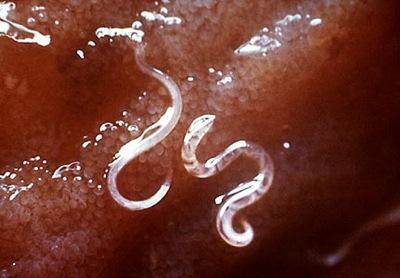Helminthic therapy
- font size decrease font size increase font size
 Do you suffer from severe form of, Crohn’s disease, ulcerative colitis, inflammatory bowel disease (IBD), multiple sclerosis, asthma, eczema, dermatitis, hay fever or food allergies? Recently, I came across a story of how a patient with severe asthma attacks treated his asthma by simply infecting himself with hookworms. Is it possible, medically proven?
Do you suffer from severe form of, Crohn’s disease, ulcerative colitis, inflammatory bowel disease (IBD), multiple sclerosis, asthma, eczema, dermatitis, hay fever or food allergies? Recently, I came across a story of how a patient with severe asthma attacks treated his asthma by simply infecting himself with hookworms. Is it possible, medically proven?
The use of parasites, as a method of treatment, is not new to us. Worm therapy, was a popular method used to lose weight, keep one’s weight in check, decades ago. And we all know about leeches having been used, for decades, in surgery and cuts to clear off excess blood and to rejuvenate blood flow where clots exist.
Helminthic therapy, a type of immunotherapy treatment of autoimmune diseases and immune disorders by means of deliberate infestation with a helminth or with the ova of a helminth, is now emerging as an alternative for treating severe forms of allergic reactions. Currently clinical trials are being conducted using helminthic therapy as a treatment for autoimmune diseases. Epidemiological studies demonstrate that parasites, and in particular helminths, have shaped the evolution of at least parts of the human immune system, and even the genes responsible for allergic diseases and provides further evidence that, it is the absence of parasites, and in particular helminths, that has caused a substantial portion of the increase in incidence of diseases of immune dysregulation and inflammation in industrialized countries in the last century. So, should we stop the fight against Helminthes infections?
Helminthes?
Helminths are parasitic worms such as hookworms and whipworms.
Two species of hookworms commonly infest humans, Ancylostoma duodenale and Necator americanus. Adult hookworms are very small, less than half an inch long and about half a millimeter wide. Hookworms are estimated to infect up to 1.3 billion people around the world. Most people who are infected are asymptomatic (without symptoms). In the tropics, where it is common, hookworm kills 65,000 people a year and afflicts hundreds of thousands with anemia. It is also among the primary causes of stunted growth and malnutrition in developing countries. It is also feared that due to the action of the helminth on the immune system, the worms suppress the immune system, they can increase the host's susceptibility to diseases like AIDS and malaria.
Hookworm infiltrates a victim's system when the larvae, hatched from eggs in infected people's excrement, penetrate the skin, often through the soles of the feet. From there, they enter the bloodstream, travel to the heart and lungs, and are swallowed when they reach the pharynx. They mature into adults once they reach the small intestine, where they can subsist for years by latching onto the intestinal wall and siphoning off blood.
Therefore, when it comes to treating immune-mediated diseases, helminthic therapy comes with a few safety issues. As it is, the aim of the therapy is to introduce germs to the human body to counteract the body's immune system, but nobody can ever vouch how the body will respond to the infections.
Despite this, our fear of “worms” or “parasites” should not keep us from considering a new treatment that could help many people.
How does it work?
The next step of course is to understand exactly how and when gut parasites program the human immune system in a way that protects against allergic sensitization. Many theories have been put forth, however they have a lot of discrepancies. To try and understand, let’s start by reviewing the pathophysiology of allergies.
An allergic reaction, a disorder of the immune system often also referred to as atopy, occurs to normally harmless environmental substances known as allergens; these reactions are acquired, predictable, and rapid. Strictly, it is one of the four forms of hypersensitivity and is called type I (or immediate) hypersensitivity. It is characterized by excessive activation of certain white blood cells called mast cells and basophils by a type of antibody known as IgE, resulting in an extreme inflammatory response.
In human beings, two distinct patterns of cytokine secretion have been defined among CD4+ helper T-cell clones: Human type 1 helper (Th1), human type 2 helper (Th2). Th2 cells provide an excellent helper function for B-cell antibody production, particularly of the IgE class. On the other hand, Th1 cells are responsible for delayed type hypersensitivity reactions and are cytolytic for autologous antigen-presenting cells, including B cells.
Most allergen- or helminth-antigen-specific human CD4+ T-cell clones exhibit a Th2 phenotype, whereas most clones specific for bacterial antigens show a Th1 profile. Allergen-specific Th2 cells seem to play a crucial role in atopy. These cells induce IgE production via IL-4 and favor the proliferation, differentiation, and activation of eosinophils via IL-5.
Eosinophils are shown to be the culprits in allergic reactions, and responsible for the tissue damage seen in asthma and related allergic diseases. However, they appear to be pluripotential, displaying distinctly differing roles in various physiological processes, including tissue homeostasis, host defence and tissue damage.
High IgE levels, seen in both helminth infections and atopic disorders, leads to mast cell degranulation and inflammation. However, Helminth- infested subjects are somehow protected from mast cell degranulation and inflammation by other allergens. The IgE blocking hypothesis explains this.
The hygiene hypothesis explains that early infections establish a Th1-biased immunity and prevent the induction of the Th2 system that causes atopy.
The worms work by reducing and in some cases stopping the inflammation reaction. This is defined as a reduction of symptoms or remission - not a cure.
Safety issues
Though it is considered an experimental therapy, so far, there is no evidence in the scientific or medical literature of harm at low infection numbers of either hookworm or whipworm.
Therefore, question is how to determine when light is light enough, and how to moderate the amount of infection. This alternative treatment must be considered very thoroughly before a decision is made to go through with it. One must chose a competent therapist to ensure controlled inoculation of the parasite.
Also, since different people respond differently to treatment, it is possible that some susceptible individuals may develop an allergic reaction (the worm antigens can be potent stimulators of the immune system). Their addition to an already over-reacting system can make things temporarily worse. It is not uncommon to experience what is known as the "worm flu". This is a period of fatigue and generalized inflammation. These symptoms usually resolve in a couple months. Therefore it is usually necessary to keep a patient at the clinic for an hour (post inoculation) for observation, followed by subsequent check-ups. You should be prepared to terminate therapy should you experience any adverse effects.
The duration it will take to see results also depend on the individual and the disease being managed. In the case of allergies there are reports of improvement in a couple weeks to a few months, however most conditions require a significantly longer period for therapeutic benefit.
Having been provided with all this information, are you ready to try helminthic therapy?

